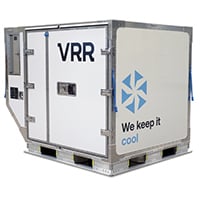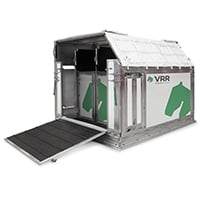It’s going to be a tough year ahead for the air cargo industry, according to many analysts: stubborn inflation, increasing freight capacity, falling spot rates, and ongoing world events are all softening demand. IATA’s forecast for 2023 supports this pessimistic view. It predicts a 4.3% decline in volume and a 22% drop in yields.
Even so, the air cargo market is still much stronger than it was pre-Covid. Average air freight rates for December 2022 were 75% higher than before the pandemic. Whether you see this as a glass half-full or half-empty type of situation, there’s no question that the industry must continue to find ways to move air cargo more quickly and more efficiently than ever before.
Ironically, the pandemic has done us a great favour in this respect. At the time, it wiped out belly cargo capacity and put stock levels of Unit Load Devices under increasing pressure. But it also shone a light on the many efficiency gaps in the movement of air cargo.
So, perhaps now is the time to coordinate our efforts, specifically to improve air cargo efficiency, to accelerate the numerous improved initiatives currently underway in our industry. In particular:
- Cargo-friendly airports
- Digitalisation of processes
- Airport Cargo Community Systems
- Digital air corridors
- Enhanced ULD management system
- Efficient ULDs and Collapsible ULDs
Infographic for solving 4 main air cargo challenges
Before we look at above areas in a little more detail, we'd like to offer you this free infographic that will help you solve 4 important challenges with our certified collapsible containers.
1. Cargo-friendly airports
Perhaps top of the list of efficiency improvements for the air cargo industry are cargo-friendly airports. What do these look like? Well, you’re best off avoiding a major airport and heading instead to a second-tier airport like Rickenbacker International Airport outside Columbus, Ohio, according to Eric Kulisch in his article ‘Cargo-friendly airports shine during COVID crisis’.
Rickenbacker exemplifies the cargo-centric approach. The way it’s set up helps accelerate loading and unloading from freighters. Airlines can even handle the cargo themselves if they wish. What’s more, several freight forwarders have air-side cargo terminals, which gives them direct control over their freight.
Freight carriers and logistic companies love the efficient set-up here, and no wonder. Evan Rosen, President of the Americas for Expo Freight Logistics, explained to Kulisch that his company could unload freight at Rickenbacker between two to four days faster than at his airline’s container freight stations at Chicago or JFK. That’s a staggering difference.
Bryan Schreiber, Manager of Air Cargo Business Development at Rickenbecker described how the crisis generated new business as freight companies scramble to non-congested airports. “We are seeing some large global freight forwarders that haven’t used Rickenbacker in a gigantic way now chartering whole aircraft into Columbus because they’re finding it easier to get the freight on the road to final destinations.”
Other shining examples of cargo-friendly airports include Rockford International Airport (near Chicago, USA), East Midlands Airport (near Birmingham, GB) and Kaunus Airport in Lithuania. Logistic handlers are finding these airports to be much more efficient than their larger cousins, who focus heavily on passenger airlines and don’t have a logistical speed advantage.
2. Digitalisation and the need to minimise manual processes
The air cargo industry is full of manual processes. Not terribly efficient, but doable if you have enough people. However, when the global health crisis hit three years ago, staffing levels around the globe took a severe hit, and they haven’t recovered yet. Surely, this is the wake-up call the industry needed to eliminate labour-intensive processes.
This is certainly the view of The International Air Cargo Association (TIACA), which highlights digitalisation as one of five critical challenges facing the air cargo industry. DHL, which is a TIACA member, clearly agrees. In May 2020 it launched myDHLi, a portal that gives shippers and freight forwarders 360° visibility of their shipments. Quotes and bookings, real-time freight tracking, documentation and data analytics are all available in one screen – across all devices.
The need to minimise manual processes is also the view of IATA. Via Digital Cargo, it’s been promoting end-to-end supply chain collaboration to streamline processes for a number of years now. But, in an industry that is considered a ‘slow digital adopter’, is progress actually being made?
Head of Digital Cargo Henk Mulder, speaking at the World Cargo Symposium in Sep 2022, thinks there is progress, thanks in large part to Covid. However, there’s still a long way to go, and he believes all businesses need to upgrade their technologies and skills if they’re to make the most of technological opportunities.
When it comes to setting digitalisation standards for the industry, IATA takes a leading role. The program ONE Record is a good example. Built on the e-freight/e-AWB initiative, which is now used for more than 2 out of 3 shipments, ONE Record creates a single record view of a shipment and shares the data via a standardized and secured web API.
The aim of ONE Record is to effectively manage the supply chain for the cargo ecosystem, which includes minimising human interaction. However, as IATA itself admits, the program needs to be further integrated with other parties and services in order to take full advantage of its capabilities. And that means companies finding the resources and time to switch to next-gen integration.
3. Airport Cargo Community Systems (ACCS)
Another great example of collaborative solutions using digital technology is the emergence of the ACCS. Basically, an ACCS is a digital information platform that cuts down on paperwork and duplicated data and that allows all community members to interface seamlessly.
By enabling all the parties involved in transporting cargo, such as forwarders, ground handlers, airlines and customs, to communicate electronically with each other, an ACCS can help improve cargo movement, reduce overall logistic costs, improve supply chain planning, and reduce duplicated work.
Major European airport hubs like Frankfurt, Brussels and Amsterdam stole the lead in establishing community systems. But other regions like Mumbai and Singapore Changi have followed their lead, and at the start of 2020 the USA got its first ACCS at Hartsfield-Jackson Atlanta International airport.
Each ACCS that’s launched uses the latest platform available to boost operational performance, helping enhance the digitisation of the air cargo supply chain—and its efficiency.
4. Digital air freight corridors
You’ve heard of trade lanes, and you’ve probably heard of air travel corridors for quarantine-free travel during the pandemic. But digital air freight corridors?
The idea has been kicking around for a while. The aim is to improve shipment visibility and to optimise the flow of cargo data between two countries or even two airport communities. All stakeholders in the supply chain would benefit, but it does require a large dose of collaboration and trust.
Stan Wraight, President of Strategic Aviation Solutions International (independent advisers and consultants to the aviation industry) would certainly like to see digital air logistics corridors connecting multiple airports. He believes they would enable the destination country to get shipment information before the goods arrive and the origin country to get status updates in real time. Such corridors would boost not just the air cargo industry but the entire logistics industry.
He’s not the only one keen to adopt a system of digital air freight corridor. Airports are too. They see the added connectivity as a gateway to faster and more reliable just-in-time deliveries. Sadly, no corridor has yet been established. The nearest we’ve got so far is a memorandum of understanding signed in 2018 by Kale Logistics Solutions and Cargonaut to create a digital corridor between the airports in Mumbai and Amsterdam. Let’s hope this initiative gets off the ground sooner rather than later.
5. Enhancing the management and control of ULD fleets
Improving the efficiency of air cargo transportation wouldn’t be possible without improving the management of Unit Load Devices (ULDs). There are roughly 900,000 ULDs in use by the world’s airlines. Rarely in the owner’s possession, a ULD might be transferred between a dozen or so different parties during a single cargo movement.
Keeping track of these essential resources is challenging for all fleet managers, especially when the ULD passes between different airlines (known as interline movement). Every time a ULD gets lost, it costs stakeholders time and money.
According to Air Cargo Eye “some five per cent of the global ULD inventory (45,000 units, worth $50million) simply go missing”. Unfortunately, the code-based system used to identify ULDs doesn’t prevent them going astray, and RFID chips and GPS systems, thought at one time to be the answer, have proved to be unviable economically.
But tracking has now entered a new and improved phase. Major carriers and ULD management companies have started using Bluetooth-enabled ULD tracking technology to analyse ULD movements. The Bluetooth tags can be linked to an e-AWB and ULD’s serial number, enabling transporters to know where their shipments are at all times.
Other digital tools are being created all the time. Take for example ACL Airshop’s FindMyULD app, which collates all the company’s ULD management services together into one seamless tool. Developments like these will certainly help to plug those efficiency gaps.
6. Maximising the efficiency of Unit Load Devices
Accurately tracking the real-time movements of ULDs is one of the solutions to efficient air cargo logistics. But what about the ULDs themselves? The basic design of the industry’s hidden heroes has remained largely unchanged for decades. Surely there are efficiency opportunities here.
At VRR, a series of collapsible containers has been developed that focuses on optimising ULD fleet efficiency, increasing storage capacity, and promoting sustainability practices. These stackable units help to reduce not only the imbalance in ULD global stocks but also repositioning costs, yet they can carry the same amount of cargo as their standard counterparts.
Innovation in ULD designs like this can help improve greatly the efficiency of ULDs—and help address the efficiency of the air cargo industry at the same time.
Few, if any, would argue that closing the many efficiency gaps in the movement of air cargo is an industry priority. We’ve highlighted just six ways to do this. There are many others. But none of them can be achieved without the willingness of all stakeholders to come together and embrace a new approach to doing business. Do you agree?












